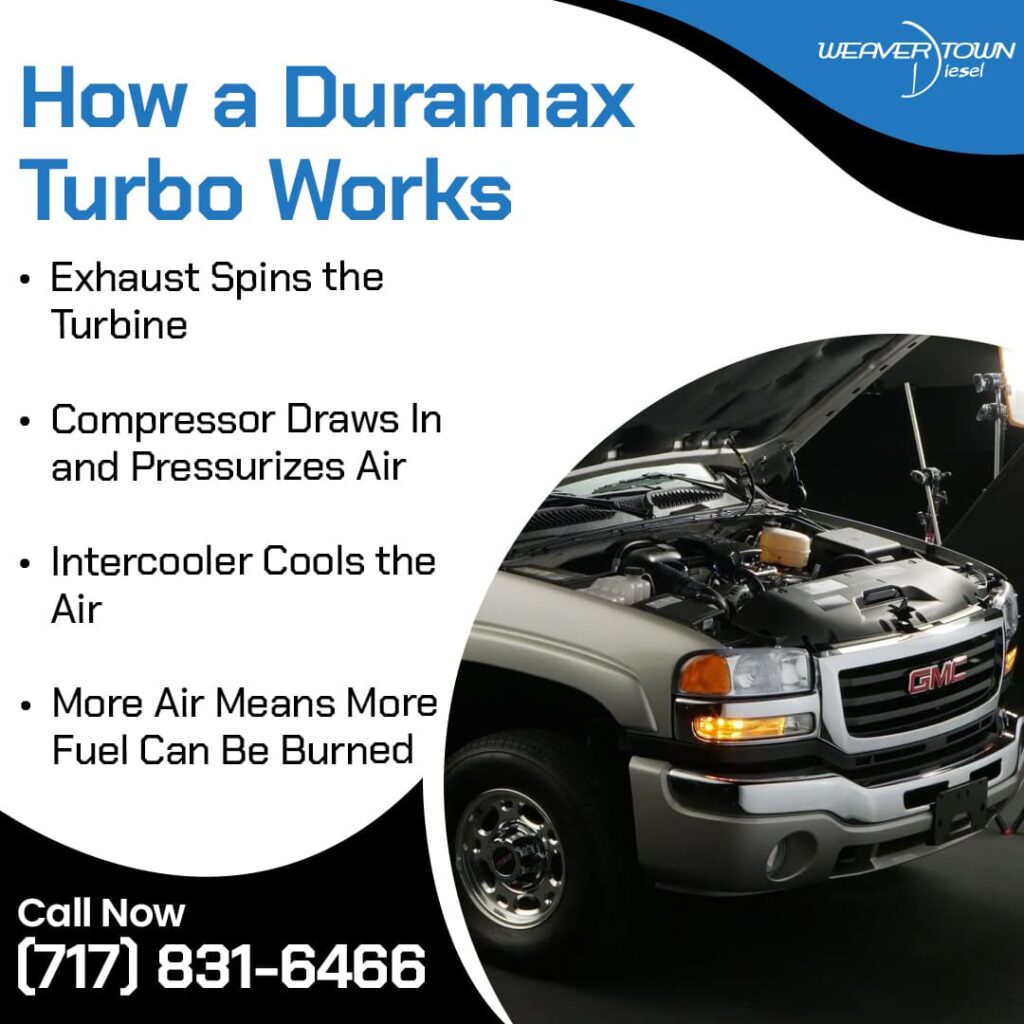Weavertown Diesel | Myerstown, PA: The Science Behind Turbocharging and How Duramax Turbos Deliver Power
Turbocharging plays a direct role in the performance of Duramax diesel engines. By increasing air volume in the combustion chamber, turbos improve torque, throttle response, and overall efficiency. At Weavertown Diesel, based in Myerstown, PA, every Duramax turbo is built with the needs of diesel truck owners in mind. Whether you’re towing, daily driving, or building for power, understanding how a turbo Duramax system works is key to making the right upgrades. Here, we’ll explain the full process of turbocharging, the specific mechanics behind Duramax diesel turbo systems, and how the right turbo can improve both engine performance and reliability.
How Turbocharging Boosts Duramax Engine Performance
Turbocharging increases engine power by forcing more air into the combustion chamber.
This gives your Duramax stronger torque, quicker throttle response, and more efficient fuel use, especially under load.
When you add a Duramax turbo, you’re giving the engine the ability to breathe with less restriction. It pushes more compressed air into the combustion chamber, so the fuel gets more oxygen to work with. That stronger burn generates more energy, which you feel immediately in towing, hauling, or climbing.
A turbo Duramax isn’t just about raw power. It’s about getting smoother performance across the full RPM range. The high compression ratio in Duramax diesel engines means they’re already efficient at turning fuel into power. A turbo sharpens that process. You don’t need to run bigger injectors or overfuel the engine. You’re simply making better use of what’s already there.
Whether you’re running a work truck or a built street machine, a well-matched Duramax diesel turbo makes the difference between standard and responsive. Even with a stock tune, you’ll notice improved boost control and more consistent pull. Upgrade the turbo, and you unlock power you couldn’t tap before.
Turbocharging gives you more with less. Instead of adding weight or building a larger engine, you’re refining how your Duramax runs—getting cleaner combustion, better output, and longer engine life.

How a Duramax Turbo Actually Works
Turbocharging might seem complex initially, but the process behind how a Duramax turbo operates is straightforward. In this section, we break it down step-by-step so you can better understand how each part plays a role in enhancing engine performance.
Step 1 – Exhaust Drives the Turbine
The process begins with exhaust gas. When the engine burns fuel, the exhaust gases are expelled under high pressure. These gases flow into the turbocharger’s turbine housing, where they spin the turbine wheel. This spinning motion is what powers the entire turbocharger system.
On the opposite end of the turbo Duramax shaft, the turbine is connected to the compressor wheel. As the turbine spins, it simultaneously drives the compressor, initiating the air intake process.
Step 2 – Compressor Pulls In and Pressurizes Air
Once the turbine has been powered, it drives the compressor wheel. This component is responsible for pulling in outside air and compressing it. The compressor forces this compressed air into the intake manifold, creating what’s known as a “boost.” Boost is a critical measure of how much extra air is being delivered to the engine.
The more boost the system creates, the greater the potential for air to fuel the combustion process, which leads to increased power output and efficiency.
Step 3 – Intercooler Cools Compressed Air
Compressed air, as a natural byproduct of turbocharging, heats up. This heated air can cause engine inefficiencies and reduce its density, meaning less oxygen for combustion. That’s where the intercooler comes in. The intercooler is a heat exchanger that cools down the compressed air before it enters the intake manifold.
By cooling the air, the intercooler makes it denser, meaning more oxygen molecules per cubic inch. This denser air improves the fuel-air mix, leading to better combustion efficiency and more power.
Step 4 – More Air Enables More Fuel Injection
Now that the air is compressed and cooled, it’s time for the engine to take advantage of it. With the increased airflow, the engine can inject more fuel into the combustion chamber based on the available oxygen. The result is more power and torque because more air allows the engine to burn more fuel.
This efficient balance of air and fuel is what makes the Duramax diesel turbo so effective, giving the truck enhanced acceleration and performance, especially under load or during towing.
Duramax Turbo Types and Sizes Explained
When selecting the right Duramax turbo for your truck, it’s important to understand how different turbo sizes and designs affect performance. The turbo Duramax system is designed to improve engine power, fuel efficiency, and overall driving experience. Still, each Duramax diesel turbo comes with characteristics that suit various driving needs.
What Do Turbo Sizes Like 64mm or 67mm Mean?
The numbers associated with turbo sizes, such as 64mm or 67mm, refer to the diameter of the compressor or turbine wheel. This size is critical because it directly affects how much air the turbo can move and how efficiently it operates under different conditions.
A 64mm turbo is generally quicker to spool up, meaning it can deliver more power at lower RPMs. This makes it ideal for applications like towing or daily driving, where responsive power at lower speeds is important. You’ll notice that 64mm turbos help to get your engine running smoothly even when you’re hauling heavy loads.
On the other hand, a 67mm turbo has a larger compressor or turbine wheel, which allows it to move more air. This means it produces more power at higher RPMs, making it better suited for performance driving or scenarios where you need maximum output, such as high-speed acceleration or racing. It’s not as quick to spool up as the 64mm, but once it’s moving, it’s highly efficient at generating substantial power.
Both sizes have their advantages, and the choice between them comes down to what you need from your Duramax diesel turbo. Larger wheels provide more power at high speeds, while smaller wheels tend to offer quicker acceleration and a more immediate boost.
Fixed vs. Variable Geometry Turbos (VGT)
In the case of turbo Duramax systems, another important distinction is between Fixed Turbos and Variable Geometry Turbos (VGT). VGTs use vanes within the turbo to adjust the angle at which exhaust gases hit the turbine wheel. This means they can control airflow to the turbine, helping to reduce turbo lag and improve throttle response.
VGTs are especially effective in improving drivability, as they can adjust in real time to provide the right amount of power when it’s needed most. They provide smoother acceleration and maintain consistent performance across a wider range of driving conditions. However, VGTs require more maintenance compared to fixed turbos. The moving parts involved can wear down over time, leading to potential reliability concerns if not properly cared for.
Fixed turbos, in contrast, are simpler in design and more durable. They do not have moving parts like the vanes in a VGT, making them a good option for those looking for long-term reliability with less maintenance. The downside is that fixed turbos do not provide the same level of flexibility in adjusting airflow, meaning they may not offer the same performance benefits in terms of reducing turbo lag or improving throttle response, especially in varying driving conditions.
When choosing between these two options for your Duramax diesel turbo, it’s important to balance performance needs with long-term reliability and maintenance requirements. Fixed turbos may be the best choice for reliability, while VGTs are a great option for those who want a more responsive driving experience.
Why Proper Turbo Sizing Matters for Duramax Owners
Choosing the right size for your Duramax turbo is vital for your truck’s performance and engine health. Picking a turbo Duramax that’s either too big or too small can lead to serious issues, affecting drivability and long-term engine health.
Oversized Turbos Can Cause Lag in Daily Driving
If the Duramax turbo is too large, it might take too long to spool up, especially when driving in city traffic or during daily commutes. This turbo lag can result in a sluggish response when you press the accelerator. It can also make it harder to manage fuel efficiency when you need smoother, more consistent power, which is critical for everyday driving.
Undersized Turbos Can Overheat Under Load
On the other hand, using a Duramax diesel turbo that’s too small can cause it to overheat when under load. When the turbo is undersized, it works harder than it should to force air into the engine, causing excessive heat. This can reduce the lifespan of your turbo and engine components, especially during heavy towing or high-performance driving.
Finding the Ideal Turbo Size for Your Use
The ideal turbo Duramax size depends entirely on what you plan to use your truck for. For towing, a smaller turbo might work better, as it will spool up faster to give you quicker, more responsive power. If you’re into racing or need more power at higher speeds, a larger turbo might be more suitable.
A properly sized turbo that delivers balanced mid-range power and fuel efficiency supports smoother daily driving. Selecting the appropriate Duramax turbo size depends on matching the engine’s capabilities with your specific performance and usage requirements.

The Role of Weavertown Diesel in Duramax Turbo Performance
At Weavertown Diesel, based in Myerstown, PA, we focus on providing high-performance Duramax turbo solutions that combine power and durability. Since our establishment in 2017, we’ve been dedicated to enhancing Duramax diesel turbo performance, with a clear emphasis on real-world testing and long-lasting reliability. We aim to offer products that continue to perform over time, no matter the conditions.
In-house Turbo Production and Testing
We take pride in designing and building every Duramax turbo in-house. By handling the entire process ourselves—from engineering to production—we make sure that each turbo meets the highest standards of performance and quality. This level of control allows us to guarantee the reliability of every turbo Duramax that we sell. Our products are engineered to perform in a variety of driving conditions, from everyday driving to demanding workloads like towing.
Rigorous Durability and Performance Testing
At Weavertown Diesel, durability is just as important as performance. We subject every Duramax turbo to extensive testing to make sure that it can handle the stress of real-life driving conditions. Our testing processes replicate the loads and demands that come with heavy towing, racing, and daily driving. This allows us to focus on producing products that don’t just provide raw power but also guarantee longevity and reliability for the long haul.
Our Commitment to Quality
What sets Weavertown Diesel apart is our dedication to providing products that stand the test of time. We aim to deliver Duramax turbos that offer not just peak performance but also dependable reliability, day in and day out. Whether you’re driving for work or play, we make sure that our turbos are built to meet your needs. By combining thorough testing with our in-house production, we offer you a Duramax turbo you can trust to perform when you need it most.
Get the Performance You Deserve with Weavertown Diesel
Ready to upgrade your truck’s turbo performance? Trust Weavertown Diesel for high-quality, reliable Duramax turbos designed to last. Whether you’re towing, racing, or daily driving, we have the right turbo for you.
Contact us today at (717) 831-6466 or email [email protected] for expert advice and the best turbo solutions. Let Weavertown Diesel enhance your truck’s performance—reliability, power, and durability are just a call away!
